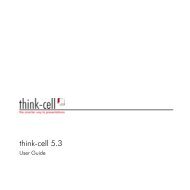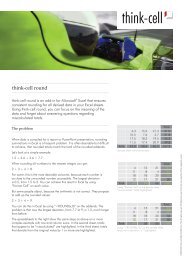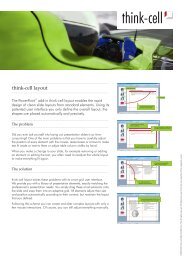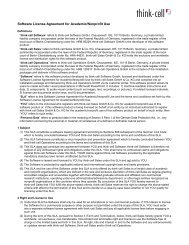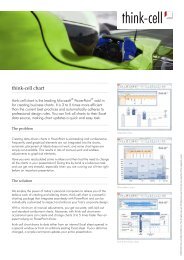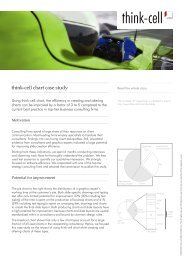think-cell technical report TC2003/01 A GUI-based Interaction ...
think-cell technical report TC2003/01 A GUI-based Interaction ...
think-cell technical report TC2003/01 A GUI-based Interaction ...
Create successful ePaper yourself
Turn your PDF publications into a flip-book with our unique Google optimized e-Paper software.
5.2 An Application of Dynamic Programming IMPLEMENTATION<br />
I suggest that to a large degree it is possible to foresee the user’s intention and<br />
place the pasted shapes where they are meant to be. Some key indicators that can<br />
help to understand the user’s intention are:<br />
• Spatial proximity of edges<br />
• Similarity of shapes in terms of type and formatting<br />
• Patterns that indicate a common case, such as a table row being inserted<br />
These hints can be encoded in a cost function that – given the environment of<br />
the source shapes and that of the destination slide – calculates the costs of some<br />
source gridline being placed before, on, or after some destination gridline. When<br />
every aspect perfectly fits, the costs will be zero; the more counter indication is<br />
detected for the placement in question, the bigger the costs will be. Given such a<br />
local cost function, the gridline matching problem can be seen as an optimization<br />
problem. The optimal solution is a list of source, dest and identify instructions<br />
that describes the order in which gridlines must be taken to create a matching with<br />
minimal cumulated costs.<br />
I do not present a detailed cost function here. It is plausible that a polynomial-<br />
time cost function is feasible; however, a lot of testing and fine-tuning will be<br />
required to achieve reasonable results. For the current implementation I chose a<br />
trivial cost function that takes the relative distance between a source gridline and a<br />
destination gridline as a measure for the cost, and defines the cost for “very close”<br />
to be zero. This algorithm implements a simple snapping behavior, but a much<br />
more sophisticated matching is desirable for a future version of the software.<br />
5.2.2 A Recursive Algorithm with Exponential Running Time<br />
The graph in figure 42 illustrates the interpretation of the gridline matching problem<br />
as a shortest path problem. A straight forward algorithm to find an optimal solution<br />
to this problem is presented in figure 43. The recursive MergeGridlines() function<br />
takes as input two lists of gridlines and returns the minimal costs along with the<br />
optimal path. The algorithm effectively does a complete enumeration of all possible<br />
paths from source s to target t. Assuming that the number of source gridlines n<br />
and the number of destination gridlines m are of the same order, this leads to an<br />
exponential asymptotic running time of Θ(3 n ): The algorithm does not have any<br />
loops and therefore only the recursive function calls contribute to the asymptotic<br />
running time. There are three recursive calls altogether, and for about half of all<br />
nodes in the shortest-path-graph, all three calls are carried out. I further assume<br />
that the cost function has some polynomial running time characteristics.<br />
The cost function in the recursive algorithm is called CostNext(). This is, be-<br />
cause given a certain state of the calculation, this function calculates the costs for<br />
making a source, dest or identify decision for the next gridlines (i. e., the heads<br />
of the listSource and listDest parameters).<br />
77



